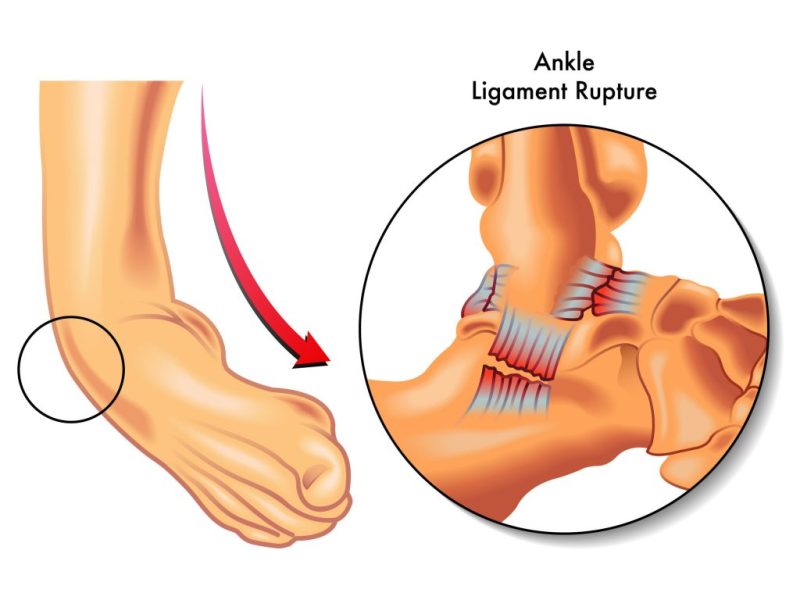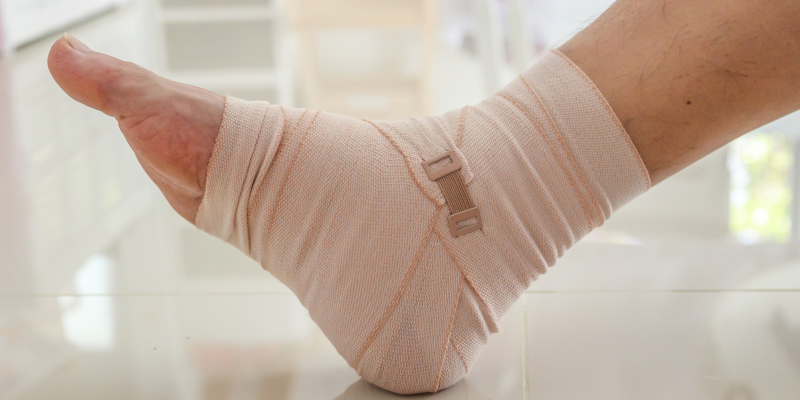One of the most common sports injuries, an ankle sprain occurs when the ligaments surrounding the ankle joint are stretched or torn as the ankle joint and the foot is turned, twisted, or forced beyond its normal range of motion.

If you suspect an ankle sprain, there are things you can do immediately after being injured to protect your ankle. Once the initial injury begins to heal, you can use exercises to rehabilitate your ankle and get back to the activities you love.
The 1st phase of rehabilitation as we explain earlier is to follow the POLICE protocol as we could divide them into Protection, Optimal Loading, Rest, Ice, Compression, and Elevation. This procedure should be applied within the first 24 to 72 hours immediately after an ankle injury.
The 2nd phase of rehabilitation is to regain the full range of movements and restore muscle strength in a graded exposure. Every individual has a different level of fitness and goals, and your physio will customize the level of intensity and your progression plan.
We have progress the strength routine in this article and also added a proprioception exercise routine to follow since you have passed through the 1st and 2nd phases of rehabilitation.
Strengthening Exercises
Step-Ups: Begin on a short step and slowly step up in a controlled manner while focusing on contracting the muscles of the foot, ankle, and leg. Turn around and slowly step down in the same manner. Repeat 20 times, several times per day.
- Resistance band Exercises: Use RB to create gentle resistance as you move through a full range of motion. Wrap the RB around the ball of the injured foot and resist the band as you move your ankle up, down, inward and outward. These exercises incorporate the four movements of the foot: inversion, eversion, plantar flexion, and dorsiflexion. Perform three sets of 15 repetitions for each movement and repeat at least 2times a day.
- Weighted Calf Raises: Stand upright holding two dumbbells by your sides. Place the balls of your feet on an exercise step or weight plate with your heels touching the floor. With your toes pointing forwards, raise your heels off the floor and contract your calves. Slowly return to the starting position repeat this exercise for 3 sets of 15 repetitions at least once a day.
Proprioception Exercises
Several studies have shown proprioception training can reduce a patient’s risk of sustaining a first time or recurrence Ankle Sprain. After you are able to place your full weight on the injured ankle without pain, you may begin proprioceptive training to regain balance and control of the ankle joint.
- Single-Leg Balance: Try to stand on one leg for 10 to 30 seconds. Increase the intensity by doing this with your eyes closed.
Single-Leg Squat (Assisted) : To perform a single leg squat, start standing up straight next to the wall with your arms next to your body. Then, bend one knee, making sure your foot is off the ground. Squat down as far as you can by bending the knee of your standing leg. Initially, you may use the wall to regain your balance.
Balance Board with Half-squats: While balancing on a wobble board, perform 5 slow, controlled half-squats. (You may use a pillow if you don’t have access to balance board).
- Balance Board Ball Toss: While balancing on a wobble board, balance board, or BOSU, catch and toss a small (2 pound) medicine ball with a partner.
- Before trying these exercises make sure to consult your strength coach or your physical therapist. If you have any question feel free to contact us through [email protected]
Our Approach
Dublin Sports Injury Clinic is a Physical Therapy Clinic based in Fitzwilliam Square, Dublin2. We have a holistic approach to our assessment and treatment. The initial assessment helps us to explore the cause of your injury and help you to get pain free shortly and stop any further injuries. We will design a customized training program for you to start with, and we will coach you and monitor your progress closely. We will prescribe relative rest or modified activities as required. Depending on the individual requirement, we apply manual therapy accompanied by stretching to restore tissue elasticity and reduce the strain in the muscle-tendon unit with joint motion.
Next step
Want to get in touch with our team of the therapist or you are looking for some advice? Simply fill in your details below & we get in touch with you shortly.
Disclaimer: This article is for information only and should not be used for the diagnosis or treatment of medical conditions. You can contact us if you would like to book an appointment or get some advice from our therapist.
